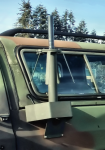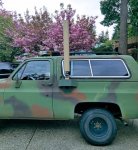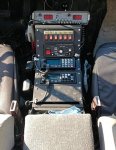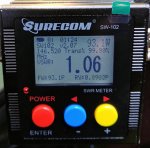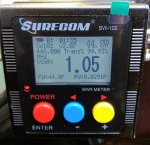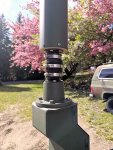- 1,555
- 1,805
- 113
- Location
- Puget Sound, WA
The following is a tutorial on converting the Duke CIED antenna to use in the ham radio bands. You choose which band(s) based on the antenna you put inside, however you should be shopping for a (1) no-groundplane antenna that (2) is a length that fits inside the tube.
My CUCV has had several iterations of “military look” antennas. I don’t want the fuss of converting a real vehicle correct antenna or the extreme expense of buying one direct from the manufacturer. 98% of the population doesn’t know what the “correct” antenna looks like anyway, and I’m not making a historically accurate truck. I just want an antenna that works and looks the part more or less.


Finally ending with the Duke CIED (trainer) antenna shown here.

By the way, this is the radio stack: one VHF M7100ip Orion making just under 100 watts for the 2 meter band, and one UHF Orion making about 45 watts for the 70cm band. Most of that is moving to the HMMWV once it has a license plate.

On to the conversion!
Here’s the antenna as it came. I have no earthly idea if this trainer antenna is functionally identical to the real thing, close, or totally different. All I know is the one I have, the trainer. I’ve never seen a real one so I can’t help with one of those (unless they’re the same).

First, remove the screws holding the top cap in place and gently pry it out. The antenna is mounted to a Plexiglas piece shown here. Disconnect the cable and remove the antenna, keep the Plexiglas bit there. Set that aside for now.

Under the base, pull those four screws and discard the connector and plate.

Mark a reference on the tube where it meets the base, then remove the screws around the base that hold the tube to the base, and carefully lift it off. The reference mark will help get the holes lined up when you reassemble.
I picked up a Comet SBB-5NMO for a couple reasons- it's the tallest that can fit inside the tube and it doesn't need a ground plane. The antenna's base has no place to mount it to the duke base, so I had a friend in a machine shop drill a big washer, and drill and tap the inside of the duke to match. This is the result:

To get there, mount an NMO to PL259 Adapter through the hole in the washer, then screw the NMO based antenna on top of that. The white wire in the picture was a redundant ground; it never got connected inside the truck and the antenna grounded to the truck body just fine with the mounting bolts (base to bracket, bracket to truck).
You would then feed the antenna cable up through the base and connect it to the UHF connector under the Comet (or whatever antenna you use).
Now put the tube back on the base and align the marks, then run the screws back in. Before you put the top cap back on you need to modify the plexiglass part by enlarging the hole just a bit and installing a rubber grommet in that hole. The reason for this is you want to feed the pointy end of the antenna up through that grommet as you’re putting the top cap back on. This prevents insanity, because hearing that antenna slap around inside the tube will drive you crazy. The plexiglass/grommet keep the radial centered in the tube.
Here are my SWR readings for the two radios, going through a diplexer and then out to the antenna.


My CUCV has had several iterations of “military look” antennas. I don’t want the fuss of converting a real vehicle correct antenna or the extreme expense of buying one direct from the manufacturer. 98% of the population doesn’t know what the “correct” antenna looks like anyway, and I’m not making a historically accurate truck. I just want an antenna that works and looks the part more or less.
Finally ending with the Duke CIED (trainer) antenna shown here.
By the way, this is the radio stack: one VHF M7100ip Orion making just under 100 watts for the 2 meter band, and one UHF Orion making about 45 watts for the 70cm band. Most of that is moving to the HMMWV once it has a license plate.
On to the conversion!
Here’s the antenna as it came. I have no earthly idea if this trainer antenna is functionally identical to the real thing, close, or totally different. All I know is the one I have, the trainer. I’ve never seen a real one so I can’t help with one of those (unless they’re the same).
First, remove the screws holding the top cap in place and gently pry it out. The antenna is mounted to a Plexiglas piece shown here. Disconnect the cable and remove the antenna, keep the Plexiglas bit there. Set that aside for now.
Under the base, pull those four screws and discard the connector and plate.
Mark a reference on the tube where it meets the base, then remove the screws around the base that hold the tube to the base, and carefully lift it off. The reference mark will help get the holes lined up when you reassemble.
I picked up a Comet SBB-5NMO for a couple reasons- it's the tallest that can fit inside the tube and it doesn't need a ground plane. The antenna's base has no place to mount it to the duke base, so I had a friend in a machine shop drill a big washer, and drill and tap the inside of the duke to match. This is the result:
To get there, mount an NMO to PL259 Adapter through the hole in the washer, then screw the NMO based antenna on top of that. The white wire in the picture was a redundant ground; it never got connected inside the truck and the antenna grounded to the truck body just fine with the mounting bolts (base to bracket, bracket to truck).
You would then feed the antenna cable up through the base and connect it to the UHF connector under the Comet (or whatever antenna you use).
Now put the tube back on the base and align the marks, then run the screws back in. Before you put the top cap back on you need to modify the plexiglass part by enlarging the hole just a bit and installing a rubber grommet in that hole. The reason for this is you want to feed the pointy end of the antenna up through that grommet as you’re putting the top cap back on. This prevents insanity, because hearing that antenna slap around inside the tube will drive you crazy. The plexiglass/grommet keep the radial centered in the tube.
Here are my SWR readings for the two radios, going through a diplexer and then out to the antenna.
Attachments
-
624.5 KB Views: 263
-
345.2 KB Views: 261
-
140.2 KB Views: 267
-
111 KB Views: 262
-
63.9 KB Views: 269
-
77.5 KB Views: 269
-
62.8 KB Views: 267
-
82.3 KB Views: 263
-
92.1 KB Views: 258
-
115.6 KB Views: 259
Last edited:




